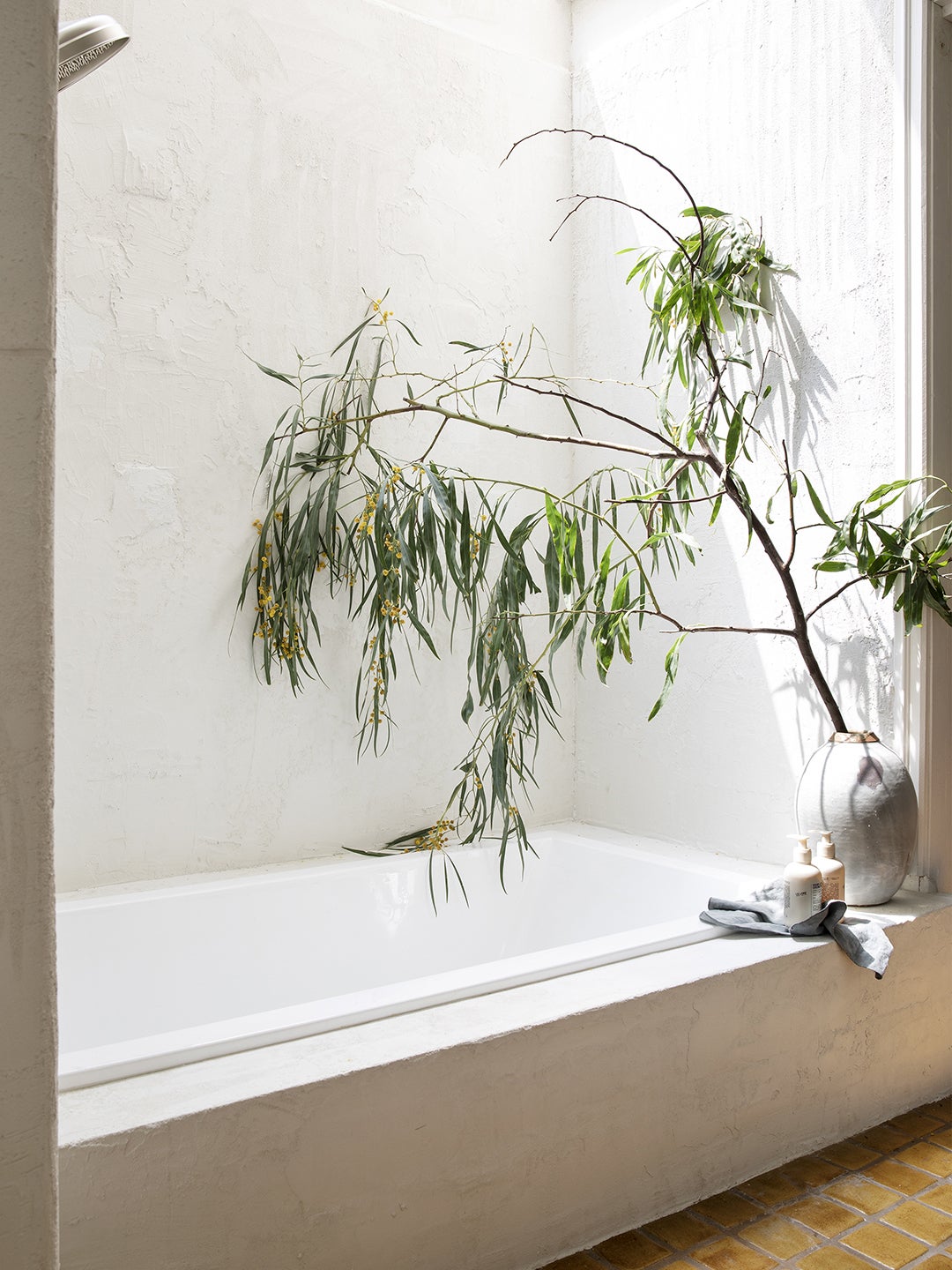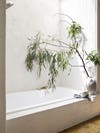Leanne Ford’s Secret to Textured Bathroom Walls Without a Gut Reno
This concrete mix saves you the trouble of ripping out tile.
Updated Oct 11, 2018 1:43 PM
We may earn revenue from the products available on this page and participate in affiliate programs.
The best way to describe the tile in our master bathroom is decorative. The dated orange-and-green design was interesting enough, but I knew that if I kept it, our Pacific Palisades home wouldn’t feel like my house. It would feel like I was living in someone else’s space. I wanted to lighten and simplify the walls, ceiling, and shower while keeping the layout the same, so I used an old trick to get instant results: SureCrete.
I’ve used the concrete coating during tons of projects in the past, including for my husband Erik Allen Ford’s Buck Mason stores. The cement-based overlay has so much dimension to it that when the light hits it, it has this 3D effect. Warning: The product is mushy and messy (it’s kind of like working with oatmeal), but if you prep the area really carefully beforehand and spread it on in a fan-like motion, you’ll get that hand-made feel. The best part is it’s waterproof if you apply a sealer, which makes it a perfect solution for the bathroom. Here’s how I do it, with some tips from the experts; my brother, Steve Ford, who first introduced me to SureCrete; and our trusted builder, Bobby Benson, who fixed up both my bathrooms.
The Supplies
- SureCrete Suretex Knockdown Overlay
- One pack of concrete powder color additive in white
- Concrete sealer
- A bucket to blend the powder
- Drywall knife and trowel (the more flexible the blade the better)
- Drywall pan
- Hopper gun (optional)
- Safety glasses
Step 1: Prep the Room
While the easiest surfaces to apply this product to are smooth ones (think concrete board), SureCrete bonds to almost anything (Bobby once covered a marble fireplace for us). If you’re doing this in a bathroom, he suggests uninstalling any fixtures that may potentially get in the way or, at the very least, covering them with a strong grout tape. Things will get messy, so be sure to wear clothes that cover your skin and put on a pair of safety glasses before getting started.
Step 2: Make Your Mix
In a bucket, add a little water to the color additive pack and blend. Then mix in about a quarter of the SureTex bag—it should be the consistency of pancake batter.
Step 3: Cover Away
There are two ways to get this part done: Put it on the walls with a drywall knife or trowel or spray it on with a hopper gun. When using a hand tool, Bobby suggests starting from the bottom of the wall and spreading it in an upward motion (with the help of another person, he can usually cover 100 square feet in an hour). “The more you go over it, the smoother it becomes,” says Bobby. “But keep in mind you have about a 15- to 20-minute working window before it dries.” For that really textured look, Steve likes to apply it to random spots on the walls rather than work across the room from left to right.
Step 4: Protect the Finish
Once it sets, smooth out any spots that are too bumpy with a drywall knife. The SureTex alone isn’t waterproof. “If you’re using it in a bathroom or any place that gets wet, you need to make sure it’s sealed properly,” says Steve. My brother is a fan of SureCrete’s sealer options, but you can also use Thompson’s concrete sealer (Bobby’s choice). You don’t have to go through a massive renovation to get a spa-worthy space.
As told to Lydia Geisel.
It’s hammer time: Follow @reno_notebook for easy rental updates, clever DIYs, and tips to nail your next project.



